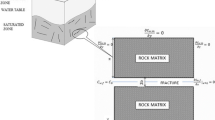Abstract
Flow and transport studies in fractured aquifers have been widely carried out by adopting the parallel plate approximation for fracture walls. However, the fractures existing in the field scenario may not always possess parallel walls and may have spatially varying fracture widths. Hence, the parallel plate conceptualization of a real fracture may be highly idealistic in some cases. The principal aim of this work is to numerically investigate the coupled dissolution and transport of benzene along a sinusoidal fracture under non-uniform flow conditions, and to compare the simulation results with the results obtained using the parallel fracture model. Results from the simulation study indicate that the parallel plate approximation of a sinusoidal fracture may lead to incorrect prediction of dissolved benzene concentration along the fracture. A sensitivity analysis is carried out to investigate the sensitivity of sinusoidal fracture parameters, such as amplitude, wavelength and average fracture aperture on the dissolution and transport of benzene within the fracture. Simulation results obtained using the parallel plate idealization of sinusoidal fractures with high amplitudes and low wavelength is found to deviate more from the real field scenario. Sensitivity of the inlet fracture pressure on concentration distribution of benzene is also analyzed. Transport of dissolved benzene is found to be significantly sensitive to fluid pressure at the fracture inlet.







Similar content being viewed by others
References
Abdel-salam A, Chrysikopoulos CV (1995) Modeling of colloid and colloid-facilitated contaminant transport in a two-dimensional fracture with spatially variable aperture. Trans Porous Med 20:197–221
Bagalkot N, Suresh Kumar G (2017) Effect of random fracture aperture on the transport of colloids in a coupled fracture-matrix system. Geosci J 21:55–69. doi:10.1007/s12303-016-0020-2
Barenblatt GI, Zheltov IP, Kochina IN (1960) Basic concepts in the theory of seepage of homogeneous liquids in fissured rocks. J Appl Math 24:852–864
Brush DJ, Thomson NR (2003) Fluid flow in synthetic rough-walled fractures: Navier-stokes, stokes, and local cubic law simulations. Water Resour Res 39:1085–1100. doi:10.1029/2002WR001346
Cvetkovic V, Selroos JO, Cheng H (1999) Transport of reactive tracers in rock fractures. J Fluid Mech 378:335–356
Grindrod P, Lee AJ (1997) Colloid migration in symmetrical non-uniform fractures: particle tracking in three dimensions. J Contam Hydrol 27(3–4):157–175
Grisak GE, Pickens JF (1980) Solute transport through fractured media 1. The effect of matrix diffusion. Water Resour Res 16:719–730
Ishii AL, Healy RW, Striegl RG (1989) A numerical solution for the diffusion equation in hydrogeologic system. USGS, Water-Resources Investigation Report 89(4027):86
James SC, Chrysikopoulos CV (2000) Transport of polydisperse colloids in a saturated fracture with spatially variable aperture. Water Resour Res 36:1457–1465
Larsson M, Oden M, Niemi A, Neretnieks I, Tsang C (2013) A new approach to account for fracture aperture variability when modeling solute transport in fracture networks. Water Resour Res 49:2241–2252
Maloszewski P, Zuber A (1985) On the theory of tracer experiments in fissured rocks with a porous matrix. J Hydrol 79:333–358
Murphy JR, Thomson NR (1993) Two-phase flow in a variable aperture fracture. Water Resour Res 29(10):3453–3476
Nicholl MJ, Detwiler RL (2001) Simulation of flow and transport in a single fracture: macroscopic effects of underestimating local head loss. Geophys Res Lett 28:4355–4358
Oron AP, Berkowitz B (1998) Flow in rock fractures: the local cubic law assumption reexamined. Water Resour Res 34:2811–2825
Ranjbar E, Hassanzadeh H, Chen Z (2012) One-dimensional matrix-fracture transfer in dual porosity systems with variable block size distribution. Transp Porous Med 95:185–212. doi:10.1007/s11242-012-0039-4
Renu V, Suresh Kumar G (2016) Temporal moment analysis of multi-species radionuclide transport in a coupled fracture-skin-matrix system with a variable fracture aperture. Environ Model Assess 21:547–562
Sisavath S, Al-yaarubi A, Pain CC, Zimmerman RW (2003) A simple model for deviations from the cubic law for a fracture undergoing dilation or closure. Pure Appl Geophys 160:1009–1022
Smith L, Schwartz FW (1984) An analysis of the influence of fracture geometry on mass transport in fractured media. Water Resour Res 20:1241–1125
Steel A, Lerner DN (2001) Predictive modelling of NAPL injection tests in variable aperture spatially correlated fractures. J Contam Hydrol 49:287–310
Suresh Kumar G (2014) Mathematical modeling of groundwater flow and solute transport in saturated fractured rock using a dual-porosity approach. J Hydrol Eng 19(12). doi:10.1061/(ASCE)HE.1943-5584.0000986
Tang DH, Frind EO, Sudicky EA (1981) Contaminant transport in fractured porous media: analytical solution for a single fracture. Water Resour Res 17:467–480
Tsang YW, Tsang CF, Neretnieks I, Moreno L (1988) Flow and tracer transport in fractured media: a variable aperture channel model and its properties. Water Resour Res 24:2049–2060
Waite ME, Ge S, Spetzler H, Bahr DB (1998) The effect of surface geometry on fracture permeability: a case study using a sinusoidal fracture. Geophys Res Let 25:813–816
Wang L, Cardenas MB, Slottke DT, Ketcham RA, Sharp JM (2015) Modification of the local cubic law of fracture flow for weak inertia, tortuosity, and roughness. Water Resour Res 51:2064–2080
Zhou WF, Wheater HS (1995) Effect of aperture variation on two-phase flow in fractures groundwater quality: Remediation and Protection (Proceedings of the Prague Conference, May) IAHS Publ 22
Zimmerman RW, Kumar S, Bodvarsson GS (1991) Lubrication theory analysis of rough walled fractures. Int J Rock Mech 28:325–331
Zimmerman RW, Chen G, Hadgu T, Bodvarsson GS (1993) A numerical dual-porosity model with semi analytical treatment of fracture/matrix flow. Water Resour Res 29:2127–2137
Zou L, Jing L, Cvetkovic V (2017) Modeling of solute transport in a 3D rough-walled fracture–matrix system. Transp Porous Med 116:1005–1029
Author information
Authors and Affiliations
Corresponding author
Rights and permissions
About this article
Cite this article
Renu, V., Suresh Kumar, G. Benzene Dissolution and Transport in a Saturated Sinusoidal Fracture with non-uniform Flow: Numerical Investigation and Sensitivity Analysis. Environ. Process. 4, 587–601 (2017). https://doi.org/10.1007/s40710-017-0252-9
Received:
Accepted:
Published:
Issue Date:
DOI: https://doi.org/10.1007/s40710-017-0252-9



